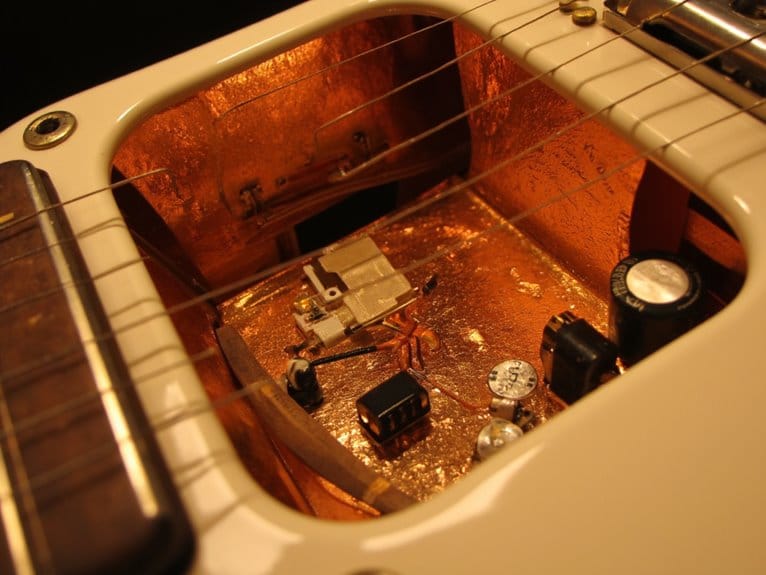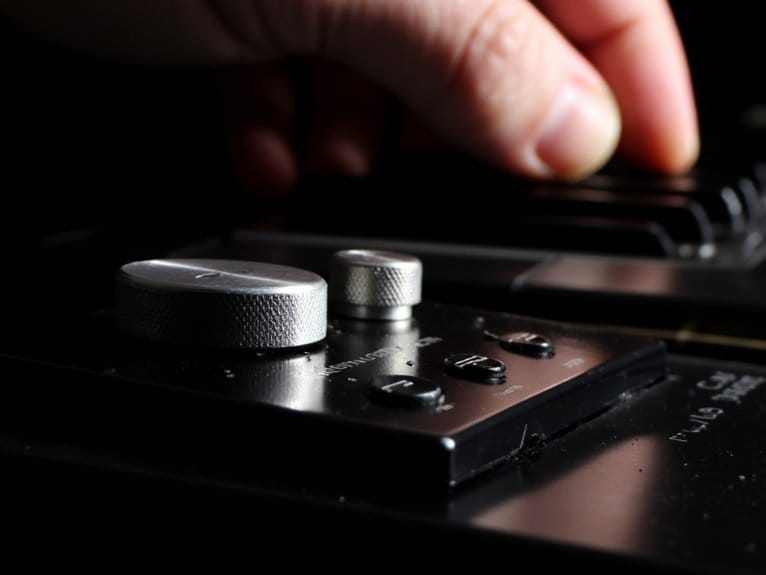Guitar Finish Types and Their Impact
Your guitar’s finish greatly impacts both sound and longevity, with each type offering distinct trade-offs. Nitrocellulose lacquer delivers exceptional resonance and bright tones but scratches easily, while polyurethane provides superior durability at the cost of some tonal openness. French polish offers the most resonant, ultra-thin coating but requires expert application, and oil finishes maximize wood’s natural voice while offering minimal protection. Understanding these characteristics helps you choose the finish that best matches your playing style and maintenance preferences.
We are supported by our audience. When you purchase through links on our site, we may earn an affiliate commission, at no extra cost for you. Learn more.
Notable Insights
- French polish and oil finishes provide exceptional resonance and tonal openness but offer minimal protection against damage.
- Nitrocellulose lacquer delivers bright tone with rich lows/mids while maintaining vintage flexibility for natural wood movement.
- Polyurethane offers superior durability and scratch resistance but may dampen resonance due to its thicker application.
- Finish thickness directly affects vibration and resonance, with thinner coats like satin/matte providing more organic, natural voice.
- Polyester ranks as the hardest finish for maximum protection, while synthetic finishes resist yellowing and cracking better.
Understanding Different Guitar Finish Types and Application Methods
While I’ve spent countless hours applying finishes to guitars over the years, I’ll admit that choosing the right finish type can feel overwhelming when you’re staring at five different options, each promising unique benefits for your instrument’s tone and protection.
French polish delivers exceptional resonance through its wiping application technique, though it requires patience with cotton-wrapped rubbers.
Oil finishes penetrate deep into wood fibers, maximizing tonal openness but offering minimal protection against wear and moisture.
Nitrocellulose lacquer provides that classic vintage flexibility while polyurethane delivers superior durability at the cost of some resonance dampening. When working with transparent finishes, it’s essential to select timber with beautiful, well-matched grain patterns that will be showcased rather than hidden.
Your application techniques will vary dramatically between hand-wiping thin coats versus spraying even coverage, with each method affecting both finish aesthetics and final performance characteristics. Just as amplifier circuit design influences tonal characteristics in guitar amplification, the finish choice fundamentally shapes how your instrument responds and resonates. Guitar cleaning kits are not universally compatible with all finish types, making proper identification crucial before maintenance.
How Guitar Finishes Affect Tone and Acoustic Performance
Though finish thickness might seem like a minor detail when you’re admiring a guitar’s gleaming surface, I’ve learned through decades of building and testing instruments that this seemingly cosmetic choice fundamentally alters how your guitar vibrates, resonates, and ultimately sounds. The vibration impact becomes immediately apparent when you compare nitrocellulose lacquer’s thin application against polyurethane’s thicker coating, with the former preserving natural wood movement while the latter adds dampening mass.
| Finish Type | Thickness | Tonal Character |
|---|---|---|
| Nitrocellulose | Thin | Bright, rich lows/mids |
| Polyurethane | Thick | Controlled, less open |
| Satin/Matte | Very thin | Organic, natural voice |
| French Polish | Ultra-thin | Exceptionally resonant |
This tonal richness difference becomes most pronounced in acoustic guitars, where every vibration directly translates to sound projection and harmonic complexity. The right finish also enhances aesthetic appeal, providing options from glossy shine to subdued looks that influence the visual impact on stage or in a collection.
Durability and Protection Levels Across Finish Options
The battle between beauty and bruises becomes crystal clear when you start comparing how different guitar finishes hold up to real-world abuse, and I’ll admit that my romantic attachment to vintage nitrocellulose lacquer has cost me plenty in repair bills over the years.
When conducting a thorough finish comparison, polyurethane and polyester emerge as the clear winners for protection, offering gymnasium-floor toughness that resists scratches, dings, and moisture damage. These synthetic finishes maintain their glossy appearance for decades without the yellowing and cracking that plagues traditional lacquers.
Key longevity factors include:
- Hardness levels – Polyester ranks hardest, followed by polyurethane, then nitrocellulose
- Thickness protection – Thicker poly coats shield against physical damage and environmental stress
- Aging resistance – Synthetic finishes don’t yellow or fade like traditional lacquers over time
Environmental Impact and Health Considerations
Beyond the scratches and dings we’ve been discussing, there’s another side to guitar finishes that I’ve become increasingly conscious of over my years of building and collecting instruments: the environmental and health costs that come with creating those beautiful, protective coatings. Traditional nitrocellulose lacquers, while prized for their tone-enhancing properties, release volatile organic compounds during application, creating respiratory hazards for luthiers and factory workers who require specialized ventilation systems and protective equipment to stay safe.
| Traditional Finishes | Eco Friendly Alternatives |
|---|---|
| VOC emissions harm air quality | Water-based formulas reduce toxicity |
| Petroleum-based ingredients | Renewable, biodegradable materials |
| Worker health effects require PPE | Safer application processes |
Fortunately, modern water-based and bio-resin alternatives offer comparable protection without compromising worker safety or environmental responsibility.
Skill Requirements and Workspace Needs for Each Finish Type
When I first started applying finishes to guitars, I quickly discovered that each type demands its own level of expertise and workspace setup.
This ranges from simple hand-rubbed oils that you can tackle in your garage to nitrocellulose lacquers that’ll require a proper spray booth and years of practice to master without ruining an expensive instrument.
Hand rubbed techniques with natural oils need minimal skills and basic ventilation, while stain application requires understanding wood absorption properties to prevent blotchy results.
Solid color finishes demand intermediate spray gun skills and dust-free environments, whereas advanced nitrocellulose work needs explosion-proof equipment and respiratory protection.
Similar to recording interfaces that require proper phantom power for condenser microphones to function optimally, guitar finishing equipment often needs external power sources rather than basic setups to achieve professional results.
- Beginner: Hand-rubbed natural finishes with basic workspace ventilation
- Intermediate: Stain and polyurethane applications requiring controlled environments
- Advanced: Nitrocellulose spraying demanding professional booth setups
Frequently Asked Questions
Can You Strip and Refinish a Guitar Without Damaging the Wood?
You can strip and refinish a guitar without damaging wood through careful guitar restoration techniques. Proper wood preservation requires patience, gentle methods, controlled environment conditions, and matching original finish types for successful results.
Which Finish Works Best for Guitars in Humid Climates?
You’ll want polyurethane or polyester finishes for humid climates since they provide superior moisture protection. Oil finishes breathe better but offer less barrier protection, while lacquer durability suffers from humidity fluctuations causing finish checking.
On a final note
You’ve now got the knowledge to choose a finish that matches your priorities, whether that’s maximizing tone, ensuring long-term durability, or finding something manageable for your skill level. Remember, there’s no universally perfect finish—nitrocellulose might give you that vintage resonance, but polyurethane’ll protect your investment better. Consider your playing style, environment, and maintenance preferences when deciding, because you’ll be living with this choice for years.







